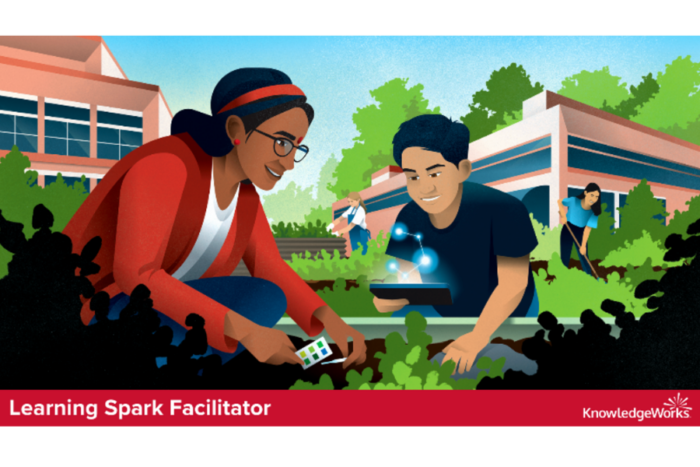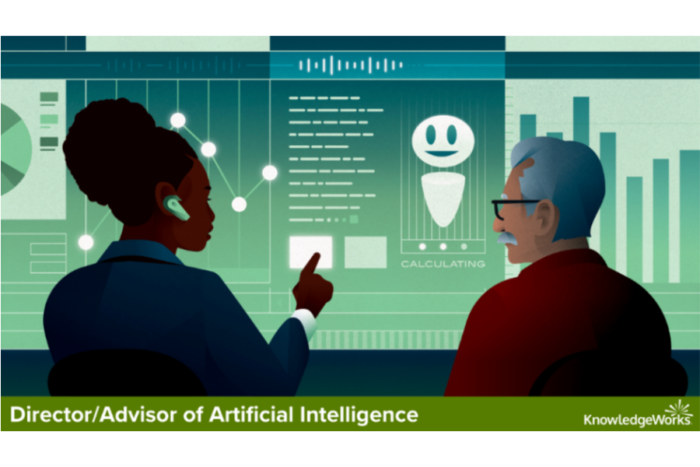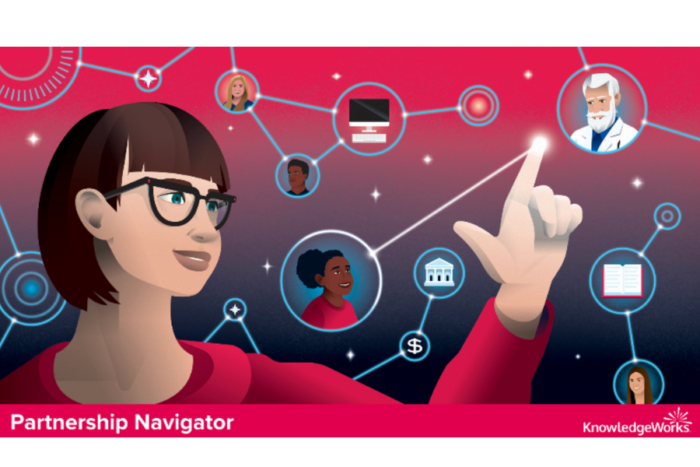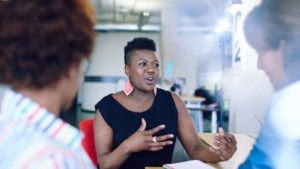Educator Roles as a Catalyst for Transformation

America’s education system was a groundbreaking effort to help a growing nation thrive in the 19th century. Now, 200 years later, the world has changed; the horizon looks drastically different. Collectively, we need to redesign our education system to enable all of our children — and, by extension, our nation — to thrive today and tomorrow. “Horizon Three” or “H3” names the future-ready system we need, one that is grounded in equity serving learners’ individual strengths and needs as well as the common good. This series provides a glimpse of where H3 is already being designed and built. It also includes provocations about how we might fundamentally reimagine learning for the future ahead. You can learn more about the horizons framing here.
By: Katherine Prince
To expand Horizon 3 schools and equitable, future-ready learning ecosystems, we must redesign educator roles. For next-generation schools and learning ecosystems to focus on deeper learning, student agency, and community-connected experiences, the people working within them need to have roles tailored to those aims. As the Learner Studio report on reimagining education highlights, “the new ‘who’ includes trained educators as well as flexible roles for other adults.”
Without deliberate, future-oriented design work, the people staffing schools will remain caught between the present and the future, constrained by outdated training and job design and restrictive structures. Moreover, the connections between schools and broader learning ecosystems will remain limited because policies and practices will continue to treat schools as separate from community-based learning sites and opportunities.
Future educator roles such as those highlighted below can help education constituents plan for the systemic structures needed to realize Horizon 3 ambitions while making schools and other learning environments better places for adults to work and more receptive to other contributors. They can also help us consider what actions we might take today to help people navigate and develop competencies for the changing landscape while steering education toward the Horizon 3 vision.
As with any aspect of planning for education transformation, reconsidering educator roles invites us to challenge core assumptions about where learning happens, what learning counts, what gets measured, and how. The roles highlighted below focus on fostering relationships and creating positive cultures in schools and other learning environments while leveraging AI where appropriate.
Sample Roles
In Envisioning Educator Roles for Transformation, KnowledgeWorks offers eight future educator roles that promise to help make schools and education systems more responsive to the needs of each learner and better places for adults to work. These roles invite consideration of what future-oriented education staffing structures could best suit next-generation schools and other learning ecosystem contributors. These roles also respond to the changing landscape around education.
A sampling of these roles are outlined below, with connections to similar roles that exist today. As you read about them, imagine the people holding these jobs work in a public middle school within a district that has engaged in a system-wide redesign around equitable, learner-centered education. The district prioritizes helping learners cultivate belonging and self-determination while mastering the competencies needed to thrive in an evolving world. A team of educators with purposefully designed roles provides interconnected supports that help learners access and enjoy personalized learning experiences. The educators also support one another in creating an infrastructure in and beyond the physical school building to ensure that the learning community can achieve its aims.
The short sketches below provide a glimpse into how the educator team interacts with a seventh-grader, Josie, her family, and the learning environment.
A learning spark facilitator would collaborate with learners and other educators to co-design equitable learning journeys for each young person they worked with. Supported by artificial intelligence (AI) tools and agents, the learning spark facilitator would establish physical and digital learning environments and link learners to opportunities to master competencies and pursue their interests. They would also foster belonging and social-emotional well-being. With an emphasis on guidance, they would spark learners’ curiosity and love of learning. This role resembles today’s classroom teacher but shifts the focus from content to engagement.
Every few weeks, seventh grader Josie meets with Ms. Lopez, a Learning Spark Facilitator, to check in on how her learning journey has been progressing. They talk about what Josie has been excited to learn and where she has struggled. They also talk about dynamics with Josie’s friends and other kids. Because Josie is passionate about environmental science and creative writing, Ms. Lopez consults with educators who have expertise in those areas and helps Josie pick assignments, projects, and other learning experiences that will help her go deeper in those content areas while also building mastery in required skills and knowledge. Ms. Lopez helps her reflect and make adjustments when needed.
A family connection coordinator would link families and caregivers to necessary supports and seed longer-term education systems transformation by involving educators, learners, families and caregivers, and community members in shaping education to meet their needs. The family connection coordinator would foster authentic communication and engagement among these constituents. Given the role’s focus on co-creating new approaches, there could come a time when it was no longer needed. Today’s family engagement specialists are closest to this role.
Once a semester, Mr. Chen reaches out to Josie’s grandmother, who cares for her, to see how things are going for them. As a Family Connection Coordinator, he previews things coming up at the middle school and checks in on whether Josie needs resources such as tutoring services or counseling referrals or whether anything has come up that is causing the family to struggle. Mr. Chen also organizes open discussions for families, students, and educators, strengthening community input into current school practices and inviting ideas for making it stronger.
A director/advisor of artificial intelligence would provide educators with the guidance and support that they needed to incorporate AI into their daily practices efficiently and ethically. This role would aim to ensure that the school’s or district’s use of AI was unbiased, enhanced the meaningfulness and relevance of instruction, and made an overall net positive impact for educators and learners. Today’s director of educational technology and instructional technology specialist roles have connections to this role.
Ms. Robinson, the district’s Director/Advisor of Artificial Intelligence, supports other educators in using AI tools wisely and ethically. For example, she collaborates with Ms. Lopez and other Learning Spark Facilitators to review the extent to which the AI tools that they have been using to inform learning journey recommendations have produced useful and meaningful results. Ms. Robinson also leads workshops, helping other educators use AI to streamline tasks and focus more on student engagement while protecting their privacy.
A partnership navigator would liaise with a wide range of organizations and individuals to help educators carry out instructional plans and bolster a school’s resources and connections. This role would build and maintain the cooperative relationships between schools and their communities that are essential for providing students with real-world learning experiences that connect academic learning to practical, meaningful applications. This role resembles today’s community partnership coordinator role but pushes for greater symbiosis among schools and their partners.
Ms. Garcia, the middle school’s Partnership Navigator, enriches Josie’s and other students’ learning by coordinating partnerships with local organizations to engage with students at the school, organize exploration days, and provide project-based learning experiences that connect classroom lessons to real-world situations. She also helps the school secure the resources that it needs to carry out its plans.
Staffing for Personalization
Together, these four educators support Josie’s personalized learning journey directly and indirectly. They engage her and her family, bring advanced tools into the school, and connect her learning to the community and real-world situations. These future roles allow everyone to contribute meaningfully to a learner-centered educational environment.
Imagining future possibilities for educator roles allows us to contemplate important questions about how we might unbundle the many functions that have been piled onto today’s educators and consider what other adults who support learning need to continue, start, and stop doing to achieve the future of learning that we desire. They also raise questions about how governments and organizations will pay for more effective education staffing structures as we move forward and when we arrive at Horizon 3. Lastly, these future educator roles invite us to consider how we might pursue incremental change and address immediate needs while laying the groundwork for Horizon 3.
The adults who support learning play a crucial role in shaping the future of education. Now is the time to explore fresh possibilities and to start crafting new educator roles, ensuring that those working in education are well-positioned and supported to bring Horizon 3 schools and equitable, future-ready learning ecosystems to life.
Putting Shape to Future Educator Roles
Designing educator roles that fit Horizon 3 schools and equitable learning ecosystems can leverage the strengths of today’s approaches to teaching and learning while building systemic structures that align with Horizon 3 objectives. As we redesign the work of humans in our schools and learning ecosystems, the first step is to consider what work will need to be done, then to construct roles that fit the work.
Key questions for designing future educator roles include:
- What responsibilities would the role involve?
- What would not be part of the role?
- What qualifications would the person holding it need?
- What type of compensation package might this role warrant?
- Would the role be full-time?
- Where would it be based?
- What working conditions would the person holding it encounter?
- What might happen if the role were filled?
- What might happen if it were not?
- What would success for a person holding the role look like?
Designing with Surrounding Change in Mind
The future will be shaped by the drivers of change that are influencing education as well as by our actions. Factors such as accelerating technologies, the intensifying climate crisis, civic polarization, and the shifting economy are affecting what could be possible for the future of learning and the future educator workforce.
As education changemakers engage in future-oriented design work, it is important to remember that the changes ahead will create both opportunities and challenges. We are not just designing for schools that reflect our Horizon 3 aspirations, but also for schools that will operate in ever-changing and increasingly complex conditions. Some emerging possibilities could limit our ability to reach our goals, while others could help us achieve them. To create effective educator roles for next-generation schools and equitable learning ecosystems, we must consider both the potential obstacles and the opportunities that lie ahead.
To start exploring the design of future educator roles, check out the template in KnowledgeWorks’ Envisioning Educator Roles for Transformation.
Katherine Prince is the Vice President of Foresight and Strategy at KnowledgeWorks.
This blog series is sponsored by LearnerStudio, a non-profit organization accelerating progress towards a future of learning where young people are inspired and prepared to thrive in the Age of AI – as individuals, in careers, in their communities and our democracy.
Curation of this series is led by Sujata Bhatt, founder of Incubate Learning, which is focused on reconnecting humans to their love of learning and creating.











0 Comments
Leave a Comment
Your email address will not be published. All fields are required.